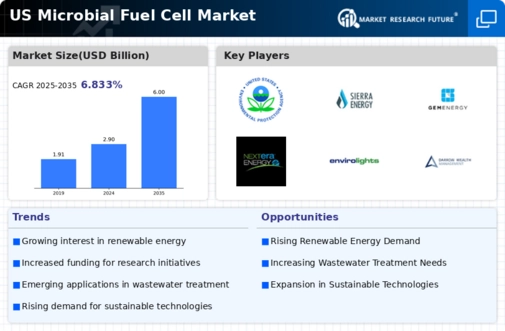Rising Energy Costs
The escalating costs of traditional energy sources are prompting a shift towards alternative energy solutions, including microbial fuel cells. As fossil fuel prices fluctuate and concerns about energy security grow, businesses and consumers are increasingly exploring renewable energy options. The microbial fuel-cell market offers a viable solution by providing a cost-effective method of generating electricity from organic waste. This trend is particularly relevant in sectors such as agriculture and food processing, where waste is abundant. The potential for cost savings, coupled with the environmental benefits, positions the microbial fuel-cell market as an attractive alternative in the current energy landscape.
Growing Environmental Awareness
The increasing awareness of environmental issues among consumers and businesses is driving the microbial fuel-cell market. As individuals and organizations seek sustainable energy solutions, the demand for technologies that reduce carbon footprints and promote renewable energy sources rises. This trend is particularly evident in urban areas, where pollution and waste management are pressing concerns. The microbial fuel-cell market is positioned to benefit from this shift, as these systems convert organic waste into electricity, thus addressing both energy needs and environmental challenges. In the US, the market is projected to grow at a CAGR of approximately 15% over the next five years, indicating a robust interest in eco-friendly energy solutions.
Government Incentives and Policies
Government initiatives aimed at promoting renewable energy technologies are significantly impacting the microbial fuel-cell market. Various federal and state programs offer financial incentives, tax credits, and grants to encourage the adoption of clean energy solutions. These policies not only support research and development but also facilitate the commercialization of microbial fuel cells. For instance, the US Department of Energy has allocated substantial funding for projects that explore innovative energy technologies, including microbial fuel cells. This support is likely to enhance market growth, as it lowers the financial barriers for businesses and researchers, fostering a more favorable environment for the microbial fuel-cell market.
Advancements in Microbial Technology
Innovations in microbial technology are enhancing the efficiency and effectiveness of microbial fuel cells, thereby driving market growth. Research institutions and companies are exploring new microbial strains and configurations that improve energy output and reduce operational costs. These advancements not only increase the viability of microbial fuel cells in various applications but also expand their potential market reach. As the technology matures, the microbial fuel-cell market is likely to see increased adoption across diverse sectors, including agriculture, wastewater treatment, and remote power generation. The ongoing research efforts suggest a promising future for the microbial fuel-cell market.
Integration with Smart Grid Technologies
The integration of microbial fuel cells with smart grid technologies is emerging as a key driver for the microbial fuel-cell market. As the energy landscape evolves, the need for efficient energy management systems becomes paramount. Microbial fuel cells can play a crucial role in decentralized energy production, allowing for localized energy generation that complements smart grid infrastructure. This synergy not only enhances energy reliability but also supports the transition towards a more resilient energy system. The microbial fuel-cell market stands to benefit from this trend, as utilities and energy providers seek innovative solutions to meet growing energy demands.



















Leave a Comment